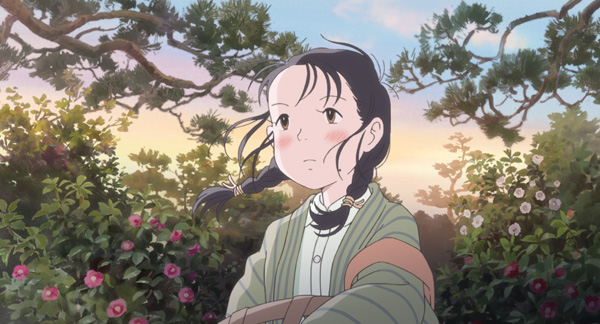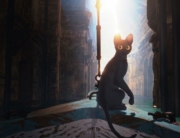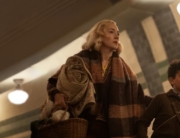In director Sunao Katabuchi’s adaptation of Fumiyo Kouno’s 2007 manga of the same name, the death and destruction of World War II are pushed into the background of a family’s normal daily life until the horror arrives on their doorstep. Hand-drawn animation and a predominantly pastel palette purvey a gentle intimacy with the innocent victims who bear the brunt of their country’s political power plays.
The film opens with protagonist Suzu (voiced by Non) as a young girl growing up in Hiroshima. She loves to draw and make up stories to go along with her illustrations. Caught up in her own dream world, she finds it hard to stay focused on the here and now. At 18, she is sent to Kure, miles from her home, for an arranged marriage to Shusaku Hojo (Yoshimasa Hosoya), who fell in love with her years before during a chance encounter that Suzu can’t recall. She determines to adapt to life in this strange new city and to work hard at being a good wife and daughter-in-law. But, in the process, she gives up her drawing.
Kure is a seaport and naval shipyard, where Suzu’s father-in-law is a naval engineer and Shusaku a navy clerk. To the citizens of Kure, the navy’s fleet seems impressive, lending a false sense of security that becomes threatened as food rations and everyday necessities become increasingly scarce and war-related casualties and deaths of friends and relatives become more frequent. Shusaku’s widowed sister, Keiko (Minori Omi), returns home with her young daughter. Grieving and bitter, Keiko takes an immediate dislike to Suzu, who she sees as usurping her role within the family and conspires to send Suzu back to Hiroshima to her family.
Suzu, more than happy to see her family again, arrives in Hiroshima and is instantly flooded with memories of all that she has sacrificed to make a life in Kure. The splendid architectural landmarks of Hiroshima (now lost forever) are beautifully rendered as poignant symbols of Suzu’s loss. She returns to her husband’s family uncharacteristically despondent until she realizes her need to start drawing again. This panacea of creativity inspires her to become more imaginative in utilizing the limited food rations, as well. (A surprising portion of the film is dedicated to highlighting her recipes.)
Repeated air raid drills have lulled the city’s occupants into complacency. The first actual raid catches Suzu outside, where the colorful explosions capture her desire to re-create them on paper, ingeniously depicted as a series of Van Gogh style images, until reality turns inspiration to guilt.
The Hojo family builds a bomb shelter, and Suzu begins directing the procedure for taking shelter. Everyday life becomes dominated by constant air raids, hours in the shelter, and always the fear that the house won’t be there when they emerge. But, even as the war destroys their city piece by piece, the residents of Kure have no idea what has befallen them when the atom bomb is dropped on Hiroshima.
There are heartrending losses toward the end, and some difficult to watch final scenes of the destruction, but Katabuchi keeps his focus on the resilience of the people, the many ways they pull together to overcome the tragedy, and their fortitude to bring a new kind of normalcy to everyday life despite their suffering. Katabuchi’s humanistic approach to a story that takes place during a war forged by extreme nationalism is a particularly timely reminder that it is not the political stakeholders who go to battle.
English subtitles, displayed in white, are sometimes difficult to read over the pastel backgrounds, and occasionally change too quickly, and some of the final scenes may be too disturbing for young children. Though for the exceptional quality of its artwork, this film is a must-see for teen and adult fans of anime.







Leave A Comment